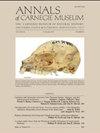确定已知最大的陆地动物:恢复灭绝动物的体积和质量的不同方法的关键比较
IF 0.9
4区 地球科学
Q4 PALEONTOLOGY
引用次数: 14
摘要
最近关于什么是已知最大的蜥脚类恐龙的说法是通过相对尺寸的最关键指标的尺寸比较来检验的-特别是,如果可能的话,背椎体中心的功能长度和结合的主干椎骨的关节长度-以及基于技术骨骼修复的模拟体积模型。白垩纪阿根廷龙重达65-75吨,它的背椎骨和背骶骨系列比任何其他描述的泰坦巨龙都要大得多。Patagotitan的标本表明它是一个50-55吨重的泰坦巨龙,而不太完整的Notocolossus, Puertasaurus和“南极龙”巨人似乎占据了类似的大小范围。Paralititan重30到55吨。幼年的无畏龙,以及富塔龙和阿拉莫龙,体重在30吨左右,最后一头可能要大得多。完全模拟的,熟练制作的,高度解剖学保真的骨骼修复和代表主要精益状态的体积模型在科学上大致是客观和准确的,并且比模拟-数字,粗糙形成的凸壳体积模型更真实,后者基于主观且经常不一致或错误地安装骨骼和数字化骨骼重建。强调需要确保骨骼修复在数据允许的情况下在解剖学上是正确和一致的,这要求研究人员和插图画家在动物,特别是恐龙解剖方面有足够的技能,并且详细说明了实现最佳结果的程序和标准。当正确执行时,模拟和数字体积模型产生足够相似的结果,可用于相互交叉检查,并且两者都比基于强度因素(如肢骨周长或某些其他骨骼尺寸)的方法更可靠地产生准确的质量,这些方法固有地受到非常高的正负因素的影响。本文章由计算机程序翻译,如有差异,请以英文原文为准。
Determining the Largest Known Land Animal: A Critical Comparison of Differing Methods for Restoring the Volume and Mass of Extinct Animals
ABSTRACT Recent claims regarding what is and is not the largest known sauropod dinosaur are tested via dimensional comparisons of the most critical metrics of relative size—especially, when possible, the functional lengths of the dorsal vertebral centra and the articulated length of the combined trunk vertebrae—and analog volumetric models based on technical skeletal restorations. The Cretaceous Argentinosaurus massed 65–75 tonnes, and its dorsal vertebrae and dorsal–sacral series are much larger than those of any other described titanosaur. Specimens of Patagotitan indicate a 50–55 tonne titanosaur, and the less complete Notocolossus, Puertasaurus, and ‘Antarctosaurus’ giganteus appear to have occupied a similar size range. Paralititan weighed between 30 and 55 tonnes. The juvenile Dreadnoughtus, as well as Futalognkosaurus and Alamosaurus, were in the area of 30 tonnes, with the possibility that the last was substantially larger. Entirely analog, skillfully produced, high-anatomical-fidelity skeletal restorations and volumetric models representing a prime-lean condition are approximately as scientifically objective and accurate, as well as more realistic than, analog-digital, crudely-formed convex hull volumetric models, which are based on subjectively and often inconsistently or erroneously mounted skeletons and digitized skeletal reconstructions. The need to ensure that skeletal restorations are as anatomically correct and consistent as the data allow is stressed, which requires that researchers and illustrators be sufficiently skilled in animal and especially dinosaur anatomy, and the procedures and standards for achieving the best possible results are detailed. When properly executed, analog and digital volumetric models produce adequately similar results that can be used to cross-check one another, and both produce accurate masses much more reliably than do methods based on strength factors such as limb bone circumferences or certain other skeletal dimensions that suffer from inherently very high plus-minus factors.
求助全文
通过发布文献求助,成功后即可免费获取论文全文。
去求助
来源期刊

Annals of Carnegie Museum
综合性期刊-动物学
CiteScore
2.50
自引率
18.20%
发文量
4
审稿时长
>12 weeks
期刊介绍:
Annals of Carnegie Museum is a quarterly journal that publishes peer-reviewed short and medium-length original scientific contributions in organismal biology, earth sciences, and anthropology, in 40 by 52.5 pica format (168 by 220 mm or 6-5/8 by 8-5/8 inches). Subject matter must be relevant to Carnegie Museum of Natural History scientific sections or Powdermill Nature Reserve (PNR), preferably with connection to the Carnegie collection and/or personnel. Carnegie Museum staff and research associates receive publication priority, but others are encouraged to submit papers, especially those manuscripts explicitly based on the Carnegie collection.
 求助内容:
求助内容: 应助结果提醒方式:
应助结果提醒方式:


